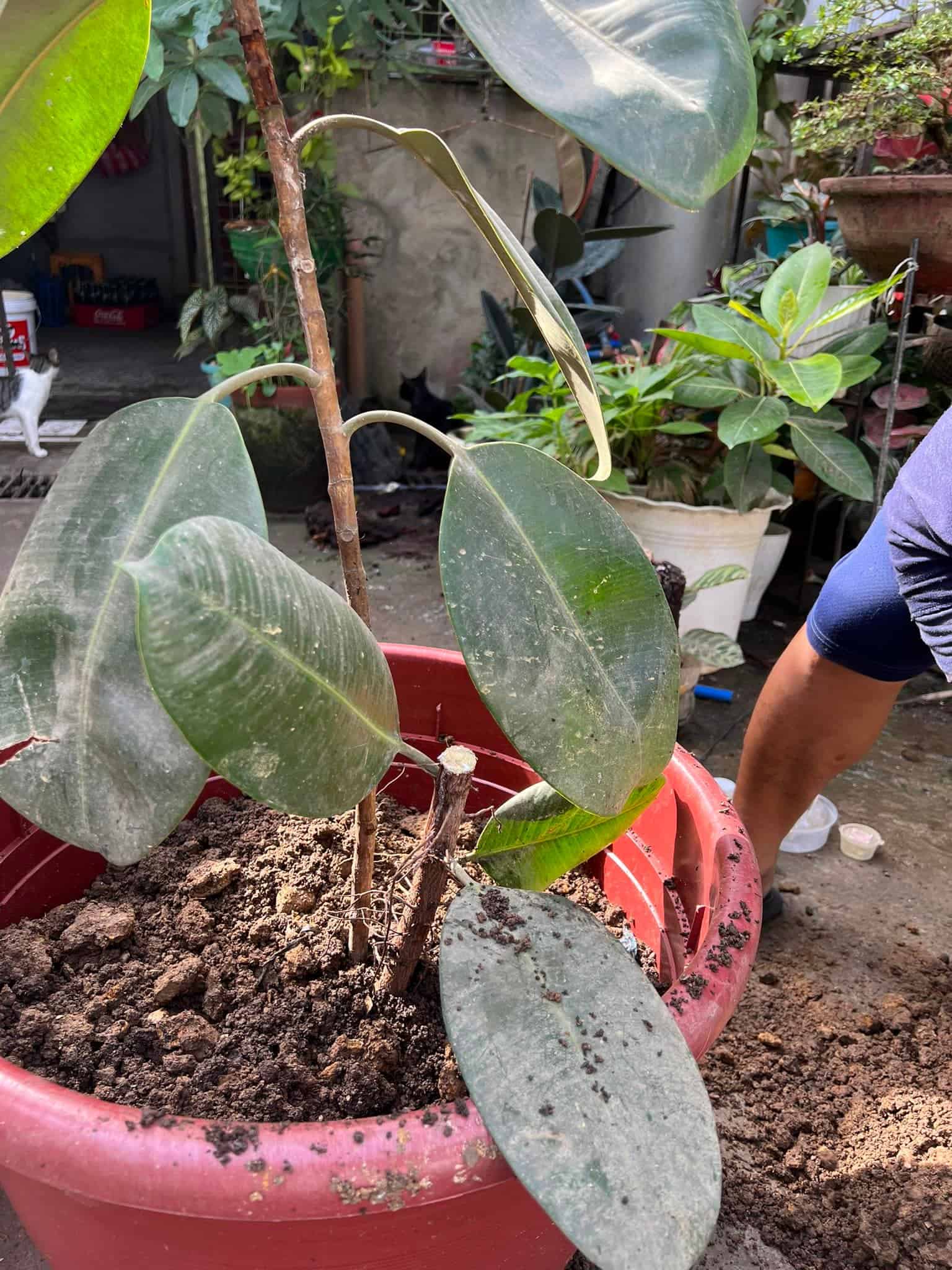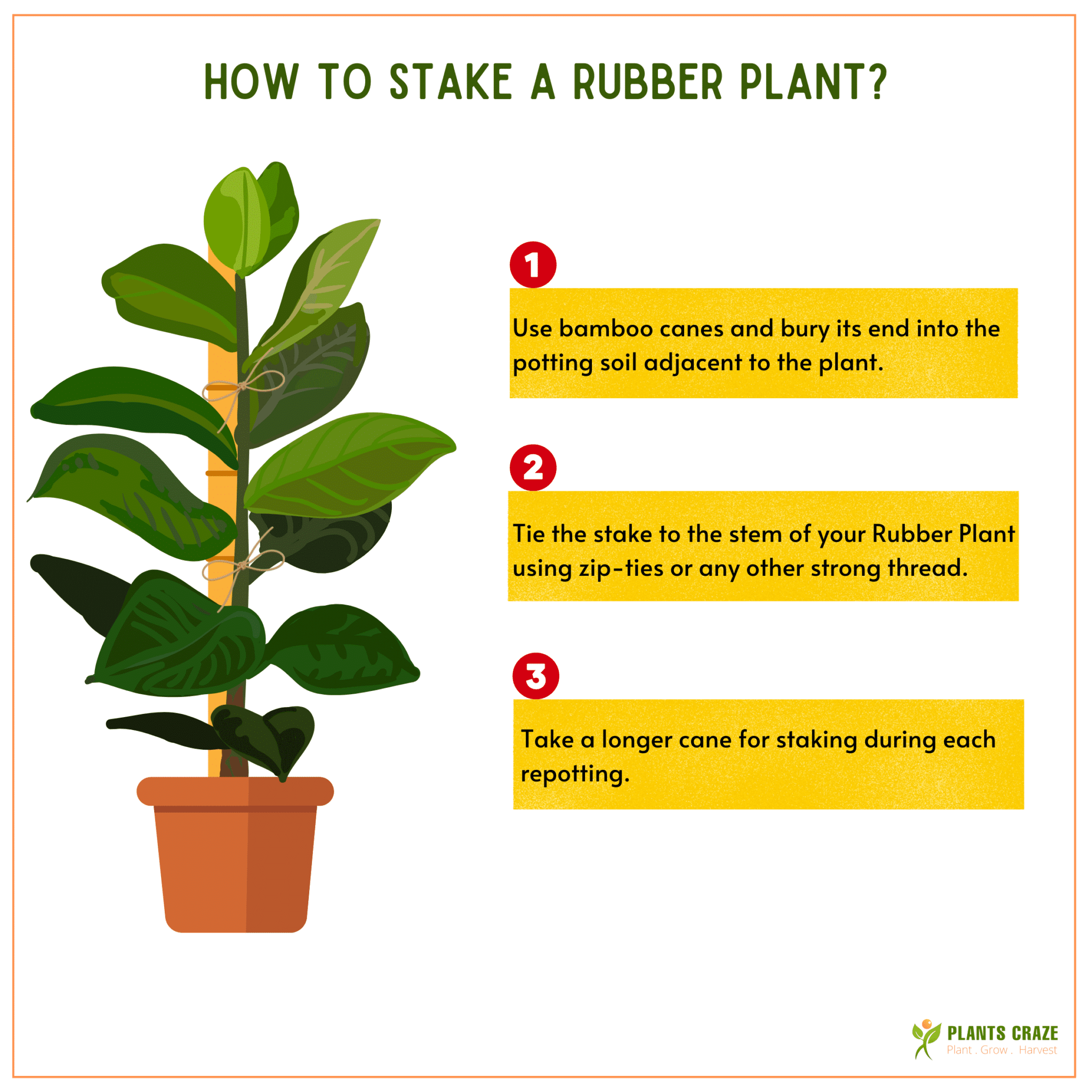Rubber Plants are active growers but cover a lot of root space and become root bound. Root bounding for long can smother the plant, and the only way left to save them is repotting.
A new pot bestows superlative growing conditions for Rubber Plants. So if you want to learn about the particulars of repotting, keep reading the article!
Table of Contents Show
Reasons to Repot a Rubber Plant
Rubber Plants love slightly root-bound conditions, but root-bound plants cannot attain a full height.
Additionally, Rubber Plants are trees, so they have deep roots, and eventually, as they age, the roots become potbound.
So, you must be mindful and watch for these signs that ensure your Rubber Plant may need a little legroom.
- Formation of cracks or crevices on the pot.
- Roots poking out from the drainage holes.
- Stunted growth and off-color bottom leaves.
- Crowding of roots on the topsoil.
- Clumpy and hard potting mix.

These signs can progress and act as catalysts for other issues like diseases, nutrient deficiency or anoxic conditions.
Eventually, the plant loses its vigor, but offering a new pot can save it, with many advantages.
- Nutrients may deplete from the soil over time, but repotting can offer fresh soil loaded with nutrients.
- A new pot grants Rubber Plant a breathable soil environment so enough oxygen can reach the roots.
- Repotting secures Rubber Plants from root rot conditions.
Best Time for Repotting Rubber Plants
Rubber plants grow new leaves, roots, stems, and flowers when they receive a hotter climate and enough sunlight, as they cannot tolerate cold.
Furthermore, Rubber Plants like potbound conditions and prefer to say in the old planter for a little more.
Frequent repotting can stress the plant, and it’s best to wait for them to show repotting signs first.
If you repot the Rubber Plant at the beginning of the spring season, the plant roots will have enough time to fit in and grow in the new pot.
Even after knowing the best time, it may remain unclear how often we should repot or if it is possible to repot on the same container. So size and type of pot are also very crucial.
What is the Pot Size for Rubber Plants?
Rubber plants are tropical to subtropical trees and grow 24 inches or more in height each season.
They prefer to grow wide and free but prefer becoming root-bound.
So a slightly wider and deeper pot is suitable if you don’t want to give them stressful transplants yearly.

Ensure not to pick an excessively larger one, as repotting to a huge pot may make the soil wet for extensive periods.
Also, choose a pot with a heavier weight if your rubber plant has gained top growth to prevent them from tipping over.
If you want a more accurate measurement, choose a pot size 1/3 times larger than the root ball of your plant.
What Type of Soil Does a Rubber Plant Need?
Rubber Plants go for soil with water-holding and drainage elements that can percolate well but retain water without getting “wet feet.”
Proper drainage is important because roots may rot without it, while water must stay in the soil to keep it green and healthy.

These kinds of Rubber Plant potting mixes are available in markets, but if you want to prepare a homemade potting mix, check the following recipe.
- Potting Soil, Organic Perlite, Pine Bark, and Sand in a 2:1:1:1 ratio.
- 3/5 Potting Soil, 1/5 Coco Chips and Horticultural Pumice and 1/5 Coco Fiber.
Additionally, compost can fortify the potting mix and maintain the acidic pH.
How to Repot a Rubber Plant?
You can keep young and small Rubber Plants in the same pot or pot of the same size for a few years.
So when mature plants demand repotting, they reveal some hints of root bounding.
At the right season, repot your Rubber Plant by following the steps below.
- Saturate the potting soil of the plant fully for 1-2 days before repotting to easily tug it out from the container.
- Take a clean pot, wash it with distilled water, and apply some isopropyl alcohol on the inner walls for disinfection.
- Place a layer of pebbles and 3-4 inches of potting soil above it at the bottom of the pot.
- From the old pot, take out all the soil and pull out your plant by grabbing the stem without hurting the leaves.
- Free the roots from soil clumps. If it feels difficult, plunge the root ball into a bucket of water and break it open.

- Check for any signs of root rot and snip the dead or pulpy roots using sterilized pruners.
- Trim any lanky roots and place the plant at the center of the pot.
- Add soil from the sides to fill the pot about 1-2 inches below the rim.
- Spread some LECA balls on the topsoil to offer extra drainage.
- Water the plant till it drains from the bottom holes, and settle it to give it time for recovery.
You can also check the following video for details about repotting Rubber Plants.
Taking Care of Repotted Rubber Plant
Although Rubber Plants grow at ease, care is necessary after repotting, so the plant doesn’t go into shock.
- Offer 6-8 hours of bright indirect sunlight daily by placing the plant near an east-facing window.
- Water every 1-2 weeks and keep the soil dry between watering schedules.
- Feed 24-8-16 liquid fertilizer every 2 weeks in spring and summer while avoiding fertilizer in fall and winter.

- Maintain a temperature around 75-80°F during the day and 60-65°F at night.
- Set the humidifier between 40% and 50% near the plant.
- Prune Rubber Plants in late spring to early summer once a year to remove overgrowths or any diseased and infested parts.
- Wash the leaves with neem oil to remove the eggs, spores, and honeydews of pests or pathogens during trimming sessions.
Rubber Plants Wilting After Repot: What to Expect?
Your Rubber Plant may wilt after repotting, as it can be stressful to plant.
It takes time to adjust to the new environment, so you don’t have to panic if the newly repotted Rubber Plant starts wilting.
You need to regularly check on your plant for the initial few days. Wilting can also be a sign of insufficient watering.
To prevent wilting after repotting, water the Rubber Plant with enough quantity regularly for a few days before repotting.
Is your Rubber Plant wilting or getting uncanny leaves? Watch out for the watering and lighting needs of your plant.
FAQs for Repotting Rubber Plant
Can a Rubber Plant Get Killed by Repotting?
Weakening of Rubber Plants after repotting is due to transplant shock and shows symptoms like wilting, off-color leaves, and leaf drops.
However, with proper soil, temperature, light, humidity, and watering, Rubber Plants eventually bounce back.
Do Rubber Plants Need Deep Pots?
Although Rubber Plants are trees that have deep roots, they like to remain in small legroom.
So, for first repotting, you can offer it a 1-2 inches deeper pot and repot in a pot with the same depth for a couple of years.
How to Aerate the Potting Soil for Rubber Plants?
You can aerate the potting soil by unclogging the drainage holes occasionally or poking holes in the topsoil with chopsticks.
From Editorial Team
Transplant Large Rubber Plants Carefully!
Rubber Plants have a milky latex that can irritate the skin. So, wear proper gloves while transplanting a mature Rubber Plant.
You can also enclose the leaves in a plastic bag, secure the branches with strings and repot it normally.


